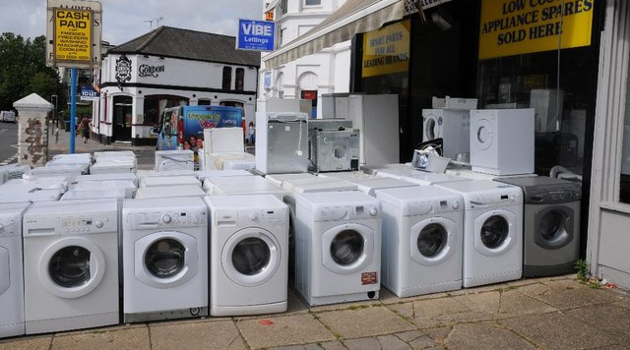When I pontificate about trade, I often point out that protectionism is a net negative for the economy.
 Yes, it is possible to erect trade barriers that benefit specific sectors and protect certain jobs, and this is the “seen” benefit.
Yes, it is possible to erect trade barriers that benefit specific sectors and protect certain jobs, and this is the “seen” benefit.
But the “unseen” costs are always far greater.
Simply stated, protectionism inevitably results in higher prices, foregone prosperity, and economic inefficiency.
Which is exactly what was determined in new research by three economists when they investigated Trump’s trade taxes on washing machines.
We analyze several rounds of U.S. import restrictions against washing machines. Using retail price data, we estimate the price effect of these import restrictions by comparing the price changes of washers with those of other appliances. We find that in response to the 2018 tariffs on nearly all source countries,
the price of washers rose by nearly 12 percent; the price of dryers—a complementary good not subject to tariffs—increased by an equivalent amount. Factoring in the effect of dryers and price increases by domestic brands, our estimates for the 2018 tariffs on washers imply a tariff elasticity of consumer prices of between 110 and 230 percent. …The result is an increase of 1.542 billion USD in consumer costs per year. …calculated duties from February 2018 to January 2019 amounted to just under 82 million USD for washing machines, and about 355,000 USD for washing machine parts. …Combining these numbers together reveals a consumer cost per job of roughly 817,000 USD annually.
Here’s a chart from the study showing how prices increased after the tax was imposed.
A report in the New York Times highlights some of the findings.
President Trump’s decision to impose tariffs on imported washing machines..is a case study in how a measure meant to help domestic factory workers can rebound on American consumers, creating unexpected costs and leaving shoppers with a sky-high bill for every factory job created.
…consumers bore between 125 percent and 225 percent of the costs of the washing machine tariffs. The authors calculate that the tariffs brought in $82 million to the United States Treasury, while raising consumer prices by $1.5 billion. And while the tariffs did encourage foreign companies to shift more of their manufacturing to the United States and created about 1,800 new jobs, the researchers conclude that those came at a steep cost: about $817,000 per job. …The costs of tariffs are paid by some combination of consumers, in the form of higher prices for the products they buy, and companies, which sometimes accept lower profit margins in order to avoid losing sales when tariffs are applied. …
Not that these findings should be a surprise.
There have been numerous studies showing that protectionism is very costly.
Indeed, the NYT story cites a few of these examples.
Other studies support the idea that tariffs are an expensive way to bolster job-creation in the United States. A study by the Peterson Institute found that tire tariffs imposed by Mr. Obama cost about $900,000 per job created. A more recent one found that Mr. Trump’s steel tariffs raised prices on steel users by $650,000 for every job they supported.
By the way, I suspect all this research is incomplete because it mostly measures how consumers have to pay higher prices.
That’s a real cost, of course, but what about secondary costs? What economic activity is being lost because consumers (in the case of washing machines) no longer have $1.542 billion available for other expenditures?
I explored this issue when writing about the green-energy programs that were part of the Obama Administration’s stimulus scheme. Here’s some of that column.
You don’t measure the job impact…simply by dividing the number of jobs into the amount of money… That only gives you part of the answer. You also have to estimate how many jobs would have been created if the $19 billion (or full $38.6 billion) had been left in the private sector rather than being diverted by the heavy hand of government.
…Keeping in mind that good analysis requires us to measure the “seen” and “unseen,” let’s now look at net job creation, which is where the rubber meets the road. The federal government is going to divert $38.6 billion from private capital markets for its green energy program, and the Administration claims this will lead to 60,000-65,000 jobs. However, based on the existing ratio of non-financial capital to employment, that same $38.6 billion, if left in the productive sector of the economy, would create about 240,000 jobs. In other words, for every one job “created” by the government, almost four jobs will be foregone. The Obama White House isn’t defending a program that spends a lot of money to create very few jobs. The Administration is defending a program that spends a lot of money and – as a result – reduces total jobs by perhaps 180,000.
I freely confessed in that column that these were back-of-the-envelope calculations, so perhaps the economic costs would show up as lower average wages instead.
None of that changes my point that the economy suffers because of government intervention (whether Obama-style fake stimulus or Trump-style trade taxes).
P.S. Mark Perry of the American Enterprise Institute added his two cents on this issue and shared these examples of costly protectionism.
P.P.S. I much prefer Reagan’s approach to trade (see here, here, and here).
———
Image credit: Philip Halling | CC BY-SA 2.0.



